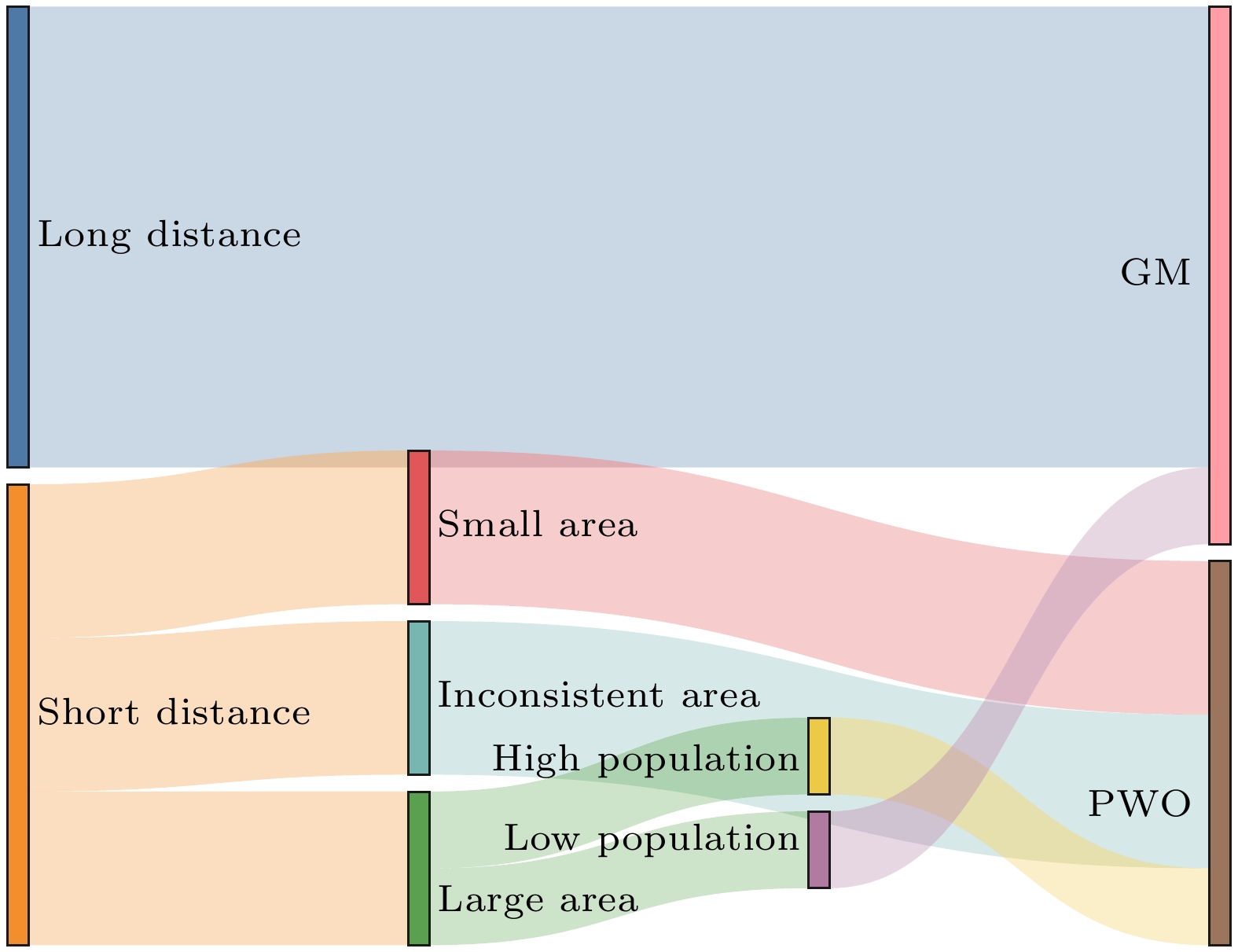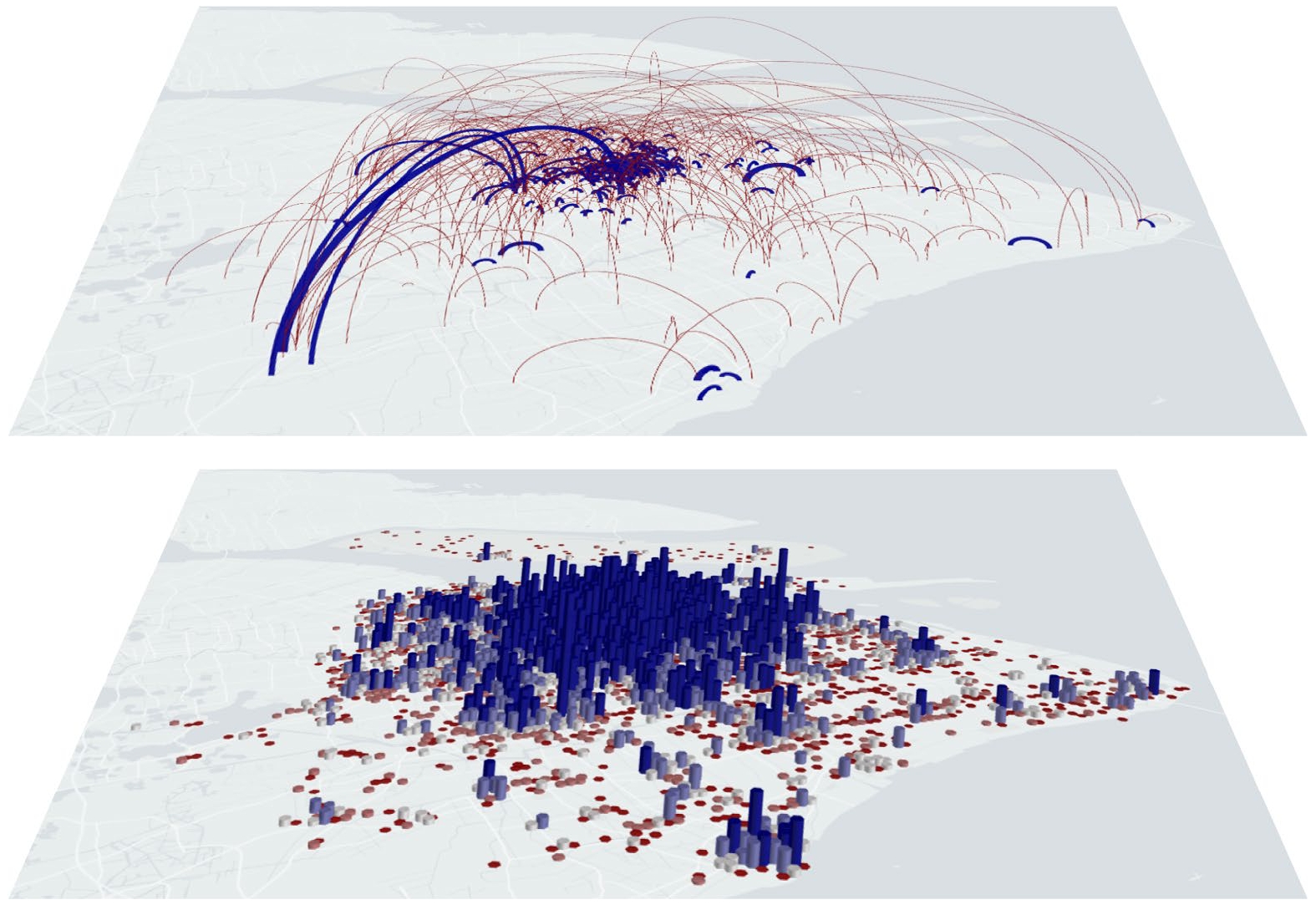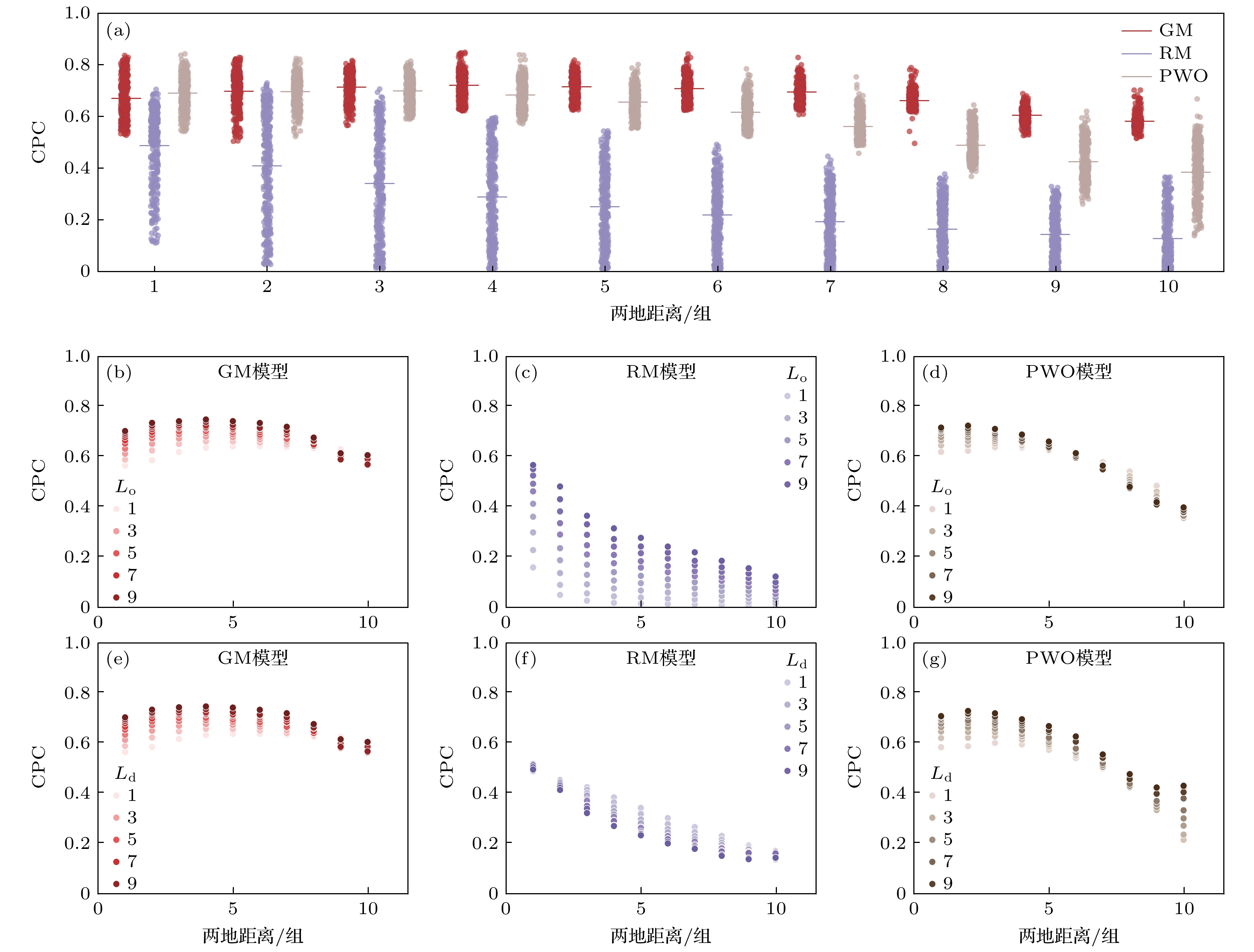-
随着城市化进程的加速, 城市人口流动的精准预测成为城市规划与政策制定的重要基础. 然而, 现有移动模型在城市场景下的适应性尚不明确, 且缺乏系统性比较, 在不同尺度下的有效性尚不清晰. 本文提出一种城市移动流量模型的跨尺度比较方法, 系统分析了引力模型、辐射模型、人口权重机会模型在不同空间、距离和人口尺度下的表现. 基于上海移动数据的实证研究表明, 引力模型受距离影响较小, 但受人口密度和区域面积差异显著影响, 性能随人口规模上升而增强, 随面积差异增大而衰减(网格边长差值大于3km时性能下降40%); 辐射模型对出发地属性敏感, 预测能力随出发地空间尺度和人口规模增加而增强, 小尺度场景存在系统性偏差; 人口权重机会模型通过人口权重机制在空间尺度上表现出优异的兼容性, 但随着距离增大效果下降, 并与人口规模正相关. 研究结果揭示了城市移动流量模型的适用场景和局限性, 为多场景下模型选择及优化提供了可操作的决策框架.With accelerating urbanization, accurately predicting intra-urban population mobility has become a fundamental requirement for urban planning and policy formulation. However, the adaptability and performance of existing mobility models across spatial scales remain unclear, and there is a lack of systematic evaluation frameworks that integrate spatial granularity, travel distance, and population heterogeneity. This study addresses these gaps by proposing a cross-scale comparative framework to evaluate three representative mobility models—the Gravity Model (GM), Radiation Model (RM), and Population-Weighted Opportunities Model (PWO)—under varying urban conditions.We construct three groups of controlled experiments using high-resolution mobile phone data from Shanghai to assess model performance across spatial (grid size), distance, and population density scales. Furthermore, we apply multivariate analysis of variance (MANOVA) to decompose the relative contributions of different spatial factors to prediction errors.The results demonstrate distinct scale sensitivities among the models. The GM model, grounded in Newtonian gravitational principles, shows high robustness over longer distances (>5 km), yet suffers from performance degradation under fine spatial granularity due to spatial heterogeneity. Its accuracy improves with population scale but decreases significantly when regional area disparities exceed a threshold—prediction performance drops by over 40% when grid size differences surpass 3 km. The RM model, based on the nearest-best-opportunity assumption, performs well for short-distance, origin-driven flows, such as commuting, but introduces systematic bias in small-scale contexts. Its sensitivity to origin population density makes it more suitable for high-density urban cores. The PWO model enhances RM by incorporating destination population weights, exhibiting superior compatibility with spatial heterogeneity in dense, polycentric cities. It performs best at short distances (<5 km) but loses effectiveness as travel distance increases.MANOVA results confirm that GM is primarily influenced by population density and area scale, whereas RM and PWO are more sensitive to distance and destination-related factors. Based on these findings, we propose a model selection strategy tailored to mobility drivers: GM is recommended for long-distance prediction in spatially homogeneous regions, while PWO is preferred for short-range flows between small, densely populated areas. RM serves as a complementary model when origin-driven flows dominate.This study not only clarifies the physical mechanisms underlying scale-dependent model performance but also offers an actionable decision-making framework for selecting appropriate models in different urban mobility scenarios. Future research can further improve predictive accuracy by developing hybrid models that combine strengths of multiple frameworks, integrating multi-source spatial data such as POIs and land use, and coupling traditional models with deep learning approaches to enhance non-linear pattern recognition while preserving interpretability. By uncovering the scale-sensitivity of mobility models, this work lays a theoretical and methodological foundation for multi-scenario mobility forecasting in smart city planning and fine-grained urban governance.
-
图 1 上海市人口及流量空间分布. 上图呈现了上海市人口流动的空间分布特征(基于抽样数据), 其中流量大小通过线条粗细和颜色深浅表示(流量越大, 线条越粗且颜色越偏蓝色); 下图展示了上海市各网格单元的人口规模分布情况, 其中网格内人口数量与柱状图高度呈正相关, 并通过颜色梯度表示(人口越多, 柱状图越高且颜色越偏蓝色; 人口越少, 柱状图越低且颜色越偏红色)
Fig. 1. Spatial distribution of population and flow in Shanghai. The upper panel depicts the spatial pattern of population flow (based on sampled data), where the magnitude of flow is represented by both the thickness of the lines and the intensity of the color (greater flow is denoted by thicker lines with bluer tones). The lower panel illustrates the population distribution across grid cells in Shanghai, where the population size within each grid is represented by both the height of the bar and a color gradient (higher population corresponds to taller bars with bluer hues, while lower population is indicated by shorter bars with redder hues).
图 2 不同网格尺度下模型效果 (a) 出发地和目的地网格尺度相等时模型预测效果; (b) 出发地网格尺度对模型效果的影响; (c)目的地网格尺度对模型效果的影响; (d)—(f) GM模型、RM模型、PWO模型关于不同网格尺度下的效果热力图
Fig. 2. the model performance at different grid scales: (a) the prediction performance of the model when the grid scales of the origin and destination are equal; (b) the impact of the grid scale of the origin on the model performance; (c) the impact of the grid scale of the destination on the model performance; (d)–(f) heatmaps of the performance of the Gravity Model, Radiation Model, and PWO Model at different grid scales.
图 3 不同距离尺度下模型效果 (a) 三种模型在不同距离尺度下的CPC值; (b)—(d) 出发地空间尺度和距离尺度的交互效应, 出发地网格边长$ L_o $越大, 颜色越深; (e)—(f) 目的地空间尺度和距离尺度的交互效应, 目的地网格边长$ L_d $越大, 颜色越深
Fig. 3. Model performance at different distance scales. (a) CPC values of the three models at different distance scales; (b)–(d) Interaction effects between origin spatial scale and distance scale; (e)–(f) Interaction effects between destination spatial scale and distance scale.
图 4 不同人口密度尺度下模型效果 (a) 出发地人口密度对模型效果的影响; (b) 目的地人口密度对模型效果的影响; (c)—(e) GM模型、RM模型、PWO模型关于不同人口密度尺度下的效果热力图
Fig. 4. Model performance at different population density scales: (a) the impact of origin population density on model performance; (b) the impact of destination population on model performance; (c)–(e) heatmaps showing the performance of the Gravity Model, Radiation Model, and PWO Model across different population scales.
表 1 不同模型多因素方差分析(ANOVA)结果
Table 1. Results of Multi-Factor ANOVA for Different Models.
因素 GM RM PWO F $ P_R > $F F $ P_R > $F F $ P_R > $F 出发地面积 9010 0.00 604629 0.00 180 0.00 目的地面积 10912 0.00 58721 0.00 38511 0.00 出发地面积: 目的地面积 9073 0.00 5132 0.00 1117 0.00 出发地人口密度 65161 0.00 179437 0.00 20934 0.00 目的地人口密度 61262 0.00 1587 0.00 127280 0.00 两地距离 688 0.00 321208 0.00 262932 0.00 -
[1] Batty M 2008 Science 319 769
 Google Scholar
Google Scholar
[2] Andrienko G, Andrienko N, Boldrini C, Caldarelli G, Cintia P, Cresci S, Facchini A, Giannotti F, Gionis A, Guidotti R, Mathioudakis M, Muntean C I, Pappalardo L, Pedreschi D, Pournaras E, Pratesi F, Tesconi M, Trasarti R 2021 Int. J. Data. Sci. Anal. 11 311
 Google Scholar
Google Scholar
[3] Barbosa H, Barthelemy M, Ghoshal G, James C R, Lenormand M, Louail T, Menezes R, Ramasco J J, Simini F, Tomasini M 2018 Phys. Rep. 734 1
 Google Scholar
Google Scholar
[4] Xu Y, Belyi A, Bojic I, Ratti C 2018 Comput. Environ. Urban Syst. 72 51
 Google Scholar
Google Scholar
[5] Guo Y T, Peeta S 2020 Travel Behav. Soc. 19 99
 Google Scholar
Google Scholar
[6] Helbing D 2001 Rev. Mod. Phys. 73 1067
 Google Scholar
Google Scholar
[7] Toole J L, Colak S, Sturt B, Alexander L P, Evsukoff A, González M C 2015 Transp. Res. Part C Emerging Technol. 58 162
 Google Scholar
Google Scholar
[8] Voukelatou V, Gabrielli L, Miliou I, Cresci S, Sharma R, Tesconi M, Pappalardo L 2021 Int. J. Data. Sci. Anal. 11 279
 Google Scholar
Google Scholar
[9] Louf R, Barthelemy M 2014 Sci. Rep. 4 5561
 Google Scholar
Google Scholar
[10] Hufnagel L, Brockmann D, Geisel T 2004 Proc. Natl. Acad. Sci. 101 15124
 Google Scholar
Google Scholar
[11] Xiong C F, Hu S H, Yang M F, Luo W Y, Zhang L 2020 Proc. Natl. Acad. Sci. 117 27087
 Google Scholar
Google Scholar
[12] NaDai M D, Xu Y Y, Letouzé E, González M C, Lepri B 2020 Sci. Rep. 10 13871
 Google Scholar
Google Scholar
[13] Simini F, Barlacchi G, Luca M, Pappalardo L 2021 Nat. Commun. 12 6576
 Google Scholar
Google Scholar
[14] Yao X, Gao Y, Zhu D, Manley E, Wang J, Liu Y 2021 IEEE Trans. Intell. Transp. Syst. 22 7474
 Google Scholar
Google Scholar
[15] Liu Z C, Miranda F, Xiong W T, Yang J Y, Wang Q, Silva C 2020 AAAI 34 808
 Google Scholar
Google Scholar
[16] Dai G N, Hu X Y, Ge Y M, Ning Z Q, Liu Y B 2021 Front. Comput. Sci. 15 152317
 Google Scholar
Google Scholar
[17] Tian C J, Zhu X N, Hu Z, Ma J 2020 Appl. Intell. 50 3057
 Google Scholar
Google Scholar
[18] Luca M, Barlacchi G, Lepri B, Pappalardo L 2023 ACM Comput. Surv. 55 1
[19] Zipf G K 1946 Am. Sociol. Rev. 11 677
 Google Scholar
Google Scholar
[20] Goh S, Lee K, Park J S, Choi M Y 2012 Phys. Rev. E 86 26102
 Google Scholar
Google Scholar
[21] Krings G, Calabrese F, Ratti C, Blondel V D 2009 J. Stat. Mech: Theory Exp. 200 9
[22] Prieto Curiel R, Pappalardo L, Gabrielli L, Bishop S R 2018 PLOS One 1 3
[23] Wang Y X, Li X, Yao X, Li S, Liu Y 2022 Ann. Am. Assoc. Geogr. 112 1441
[24] Brockmann D, Helbing D 2013 Science 342 1337
 Google Scholar
Google Scholar
[25] Stouffer S A 1940 Am. Sociol. Rev. 5 845
 Google Scholar
Google Scholar
[26] Ortúzar J D D, Willumsen L G 2011 Modelling Transport. 1 st edn. (Wiley), pp 207–208
[27] Simini F, González M C, Maritan A, Barabási A L 2012 Nature 484 96
 Google Scholar
Google Scholar
[28] Yan X Y, Zhao C, Fan Y, Di Z R, Wang W X 2014 J. R. Soc. Interface 11 20140834
 Google Scholar
Google Scholar
[29] Liu E J, Yan X Y 2019 Physica A 526 121023
 Google Scholar
Google Scholar
[30] Liu E J, Yan X Y 2020 Sci. Rep. 10 4657
 Google Scholar
Google Scholar
[31] Yan X Y, Zhou T 2019 Sci. Rep. 9 9466
 Google Scholar
Google Scholar
[32] Lawson H C, Dearinger J A 1967 J. Highw. Div. 93 1
[33] Liang X, Zhao J C, Dong L, Xu K 2013 Sci. Rep. 3 2983
 Google Scholar
Google Scholar
[34] Okabe A 1976 Reg. Sci. Urban Econ. 6 381
 Google Scholar
Google Scholar
[35] Hong I, Jung W S, Jo H H 2019 PLOS ONE 1 4
[36] Kluge L, Schewe J 2021 Phys. Rev. E 104 54311
 Google Scholar
Google Scholar
[37] Piovani D, Arcaute E, Uchoa G, Wilson A, Batty M 2018 R. Soc. Open Sci. 5 171668
 Google Scholar
Google Scholar
[38] Stefanouli M, Polyzos S 2017 Transp. Res. Procedia 24 65
 Google Scholar
Google Scholar
[39] Yang Y X, Herrera C, Eagle N, González M C 2014 Sci. Rep. 4 5662
 Google Scholar
Google Scholar
[40] Heydari S, Huang Z, Hiraoka T, De León Chávez A P, Ala-Nissila T, Leskelä L, Kivelä M, Saramäki J 2023 Travel Behav. Soc. 31 93
 Google Scholar
Google Scholar
[41] Masucci A P, Serras J, Johansson A, Batty M 2013 Phys. Rev. E 88 22812
 Google Scholar
Google Scholar
[42] Palchykov V, Mitrović M, Jo H H, Saramäki J, Pan R K 2014 Sci. Rep. 4 6174
 Google Scholar
Google Scholar
[43] Lenormand M, Bassolas A, Ramasco J J 2016 J. Transp. Geogr. 51 158
 Google Scholar
Google Scholar
[44] Lenormand M, Huet S, Gargiulo F, Deffuant G 2012 PLoS One 7 e45985
 Google Scholar
Google Scholar
[45] Gargiulo F, Lenormand M, Huet S, Baqueiro Espinosa O 2012 Jasss. 15 6
计量
- 文章访问数: 203
- PDF下载量: 2
- 被引次数: 0















 下载:
下载:





